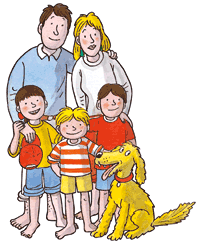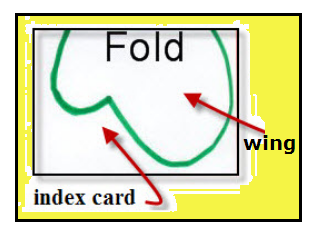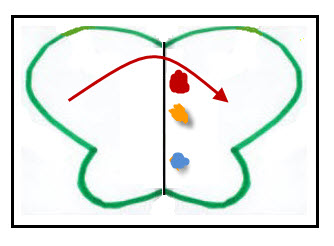Hi there, here are a few activities to try today.
Literacy –

Create a story starring the ORT characters – Mum, Dad, Biff, Chip, Kipper and Floppy. Draw what they did as a family while they were in lockdown and write what you can about it.
Numeracy – Symmetry
Butterfly wings are beautiful examples of symmetry, which means that the wings on one side of the body match the wings on the opposite side of the body. Instead of the word match, let’s say the wings are mirror images of each other like this one –
Discover for Yourself
You can use an index card to make symmetrical butterfly wings. Note: An unlined index card works best for this activity. The bigger the card, the bigger the wings.
1. Fold the index card in half by placing the short sides together.
2. Draw butterfly wings on the folded card as shown.
3. Cutting through both layers of the card, cut around the wing drawing. DO NOT CUT ON THE FOLD.
4. Open up the cut out design.
5. Using liquid paints, such as water soluble acrylic paints or tempra paints, place dots of different colors on the wings as shown.
6. Fold the the wing in half along the fold line, and then with your fingers press the wings together.You want to spread the colored dots paint.
7. Unfold the wings and VOILA’ you have beautifully colored symmetrical butterfly wings.
Discover For Yourself:
How would the following affect the appearance of the butterfly wings?
1. changing the amount of paint used for each dot
2. the colors used for the dots
3. the number of dots used
DARE TO BE CREATIVE!!!! if you don’t have paint try food instead!
Science – Life Cycles
At this time of year you might notice more wildlife. Birds are singing more and building nests. I have noticed some bumble bees around, dotting from spring flower to flower. I have not seen any butterflies yet – do you know where they come from?
Investigate the life cycle of a butterfly.
Activity: Watch the Very Hungry Caterpillar.
Can you draw a picture of each stage of the butterfly life cycle. Why do you think it is called a life cycle? Can you think of any other life cycles?
Go and explore in your garden or if you go for a walk. Look closely under stones or logs, on leaves and plants. What can you find? Listen to the sounds. What can you hear, see and smell?
Make up a dance or drama about the life cycle of a butterfly.
Have fun. Send pictures or videos of anything you do to your teacher.




